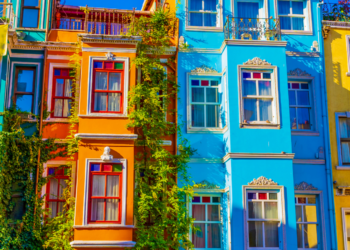No matter how many times I’m on a ferry in Istanbul, my heart skips a beat. The city is built around waterways, the Sea of Marmara, the Golden Horn and the Bosphorus Strait, each of them home to varied populations, reflecting a rich history. At one time or another Greeks, Romans, Sephardic Jews, Seljuk and Ottoman Turks called Istanbul home. All of them left their mark in underground cisterns, ancient churches, synagogues, palaces and mosques. I spend my days tracing them, walking the streets they crossed, dreaming of the lives they lived and writing about their everyday rituals. Like going to the hamam, a traditional Turkish steam bath.

History of Hamam Culture
Going to a hamam to bathe in their steamy waters takes inspiration from ancient Greek health centres and Roman thermae, public baths that functioned as social clubs where people met with friends to wash, gossip and debate. Many of the bathing rituals still popular today are a legacy of the Seljuk and Ottoman Empires and traditional hamams have separate men and women’s sections. Over the centuries numerous rules pertaining to cleanliness for every occasion, from prayer through to marriage and childbirth, were established and refined. Wealthy families attended the hamam regularly. Women would take their own satin cloth embroidered with silk or linen edged with lace to hold all their bathing essentials; the more elaborate, the higher a person’s status. Towels known as peştemal, traditionally made of pure cotton and often with hand stamped patterns and hand-finished edges were used to warm the benches where they sat, to dry their feet and cover their bodies -the best quality ones take a skilled weaver four days to complete
Traditional Hamam
In the past those going to a hamam also took bowls called hamam tası, used to pour water over their bodies. Custom made they had embossed motifs worked onto the sides and some even had precious jewels inserted into the centre. Copper dishes called kildence were used to hold soap, a kese and a comb. Most Turkish soap is made from olive oil and before shampoo, yellow or orange coloured soap called bittim, made from unripe, wild pistachios found in South Eastern Anatolia, were used to wash hair. In place of a kese, the coarse mitt used to scrub dead skin from the body, a topuk taşı, (pumice stone), was used. In keeping with the owners’ social ranking, these came encased in handcrafted silver cups and embossed with personalised designs. Lif, or loofah, were then used to remove the dead layers of the skin.
My Hamam Experience

Today, going to a hamam in Istanbul is not unlike the past. I change into my underpants and a peştemal (Turkish towel) and head into the hot belly of the hamam, a large marble steam room then I head for one of the smaller side niches and sit beside a kurna (the marble basins set into the walls to catch the water), turn on the tap above and start to slowly cascade water over myself. Next I head to the halvet, the hottest of all the rooms. The air is thick with steam and I feel my lungs begin to expand and my temperature rise. I stay there as long as I can then lie on the göbek taşı, (the raised marble platform in the middle of the room). The sound of water running into the kurna, the light from the high dome, the way sounds echo yet are muted, the steamy almost mystic quality of the air makes you want to drift off to sleep. Before I can, the masseuse comes over and goes to work on my body with kese, the layers of dead skin shed easily and my skin has a cashmere-like softness after.
The Best Hamams in Istanbul
Ayasofya Hürrem Sultan Hamam

The lavish Ayasofya Hürrem Sultan Hamam was designed by Mimar Sinan, the incomparable chief architect for the Ottoman court for Roxelana, the wife of Süleyman the Magnificent in 1556. It was the first hamam built with a women’s section exactly mirroring that of the men’s.
Çemberlitaş Hamam
Another Mimar Sinan design, the Çemberlitaş Hamam, dated 1584, was also built containing mirror image male and female sections. The light streaming through the holes in the large central dome creates a cocoon of elegant serenity.
Cağaloğlu Hamam

Built in 1741 to raise revenue to fund Sultan Mahmut’s library, the Cağaloğlu Hamam features wooden change rooms built around the waiting room while the bright white marble interior creates the feeling of floating on a cloud.
Kiliç Ali Paşa Hamam

The waiting area of the Kiliç Ali Paşa Hamam showcases the architectural glory of its bare stone walls, in stark contrast to the smooth marble of the interior rooms. Constructed between 1578 and 1583, this Mimar Sinan work was commissioned by the Ottoman admiral for whom it’s named.
Çukurcuma Hamam
Made famous in Ferzan Özpetek 1997 film Hamam, the Çukurcuma Hamam dates to the 1830s when it was built for French born Naqshidil Valide Sultan, wife of Abdulhamid I.
More Reasons Istanbul is WTF

There’s so many reasons Istanbul is worth traveling for. Like the fact it is the only city on the globe to straddle both Europe and Asia. Then there’s the city’s beautiful Bosphorus Strait, rich history, vibrant culture, elaborate mosques and museums (like the spectacular Topkapı Palace) which today stand side by side with designer hotels, hip restaurants, clubs, boutiques, and galleries. And let’s not forget its famed ‘Turkish Delight’, (or lokum as it’s known locally), find out the best places to try the sweet treat here. As for our pick of the best hotel in Istanbul, stay at the Four Seasons Istanbul on the Bosphorus.
Meet the Author
Travel writer Lisa Morrow uses her slightly imperfect Turkish language skills and sociology training to reveal the complexities of Istanbul’s rich history and Turkey’s fascinating culture. Although this once led to her being lectured by a butcher convinced she thinks Turkish sheep are born with their heads on upside down. Lisa’s by-line has appeared in BBC Travel, World Nomads, Fodors, Wine4Food, CNN Travel, Virtuoso, Al-Monitor and Skylife. Check out her website Inside Out In Istanbul and Instagram to see where she goes next.







